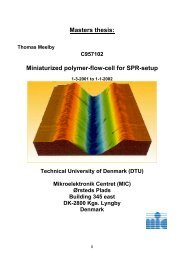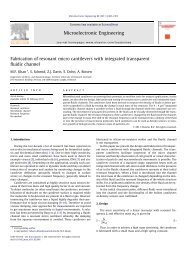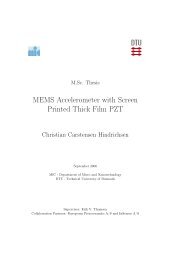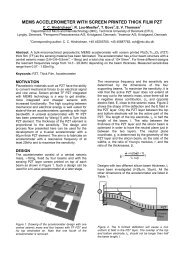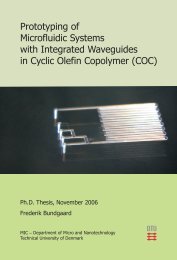C - DTU Nanotech - Danmarks Tekniske Universitet
C - DTU Nanotech - Danmarks Tekniske Universitet
C - DTU Nanotech - Danmarks Tekniske Universitet
Create successful ePaper yourself
Turn your PDF publications into a flip-book with our unique Google optimized e-Paper software.
5 Freezing Different Samples using<br />
Peltier Cooling<br />
This chapter describes the feasibility to use Peltier elements for freezing different samples.<br />
In a first test series the most suitable design of a freezing chamber for Peltier cooling was<br />
figured out by freezing phosphate buffered saline (PBS). As main material PMMA was<br />
used for the freezing chamber because of the possibility to make a rapid prototyping by<br />
using the CO2–laser. In subsequent experiments we determined the viability of E. coli<br />
after freezing the cells using Peltier cooling. The last tests engaged the freezing of different<br />
volumes and the temperature during the freezing of PBS–buffer. PBS–buffer was used as a<br />
standard, because our cell culture was diluted in PBS. While PBS–buffer was the standard,<br />
in addition the freezing tests with different volumes were made with Luria–Bertani–medium<br />
(LB–medium), because in a bio–microreactor the extracellular metabolites of the E. coli cells<br />
will be normally dissolved in LB–medium or a variation of the LB–medium.<br />
5.1 Materials and Methods<br />
5.1.1 Fabrication of four different freezing chambers<br />
The freezing chambers had a round vessel with a diameter of 8 mm and working volumes<br />
from 75 µl to 100 µl. By fabricating the freezing chambers, the focus was on the bottom of<br />
the vessel, since the Peltier element was beneath the vessel and thus a good negative heat<br />
transfer through the bottom of the vessel was needed. The main part of all freezing chamber<br />
vessels consisted of PMMA. We tested four different designs: the PMMA plate in design I<br />
and II was only machined with the CO2–laser (shown in Fig. 5.1). For design III and IV we<br />
also needed the CO2–laser, but in III, the bottom of the vessel consisted of an aluminium foil<br />
which was glued to a laser machined PMMA plate with vacuum grease, and for fabricating<br />
the bottom in IV, a PMMA foil was thermally bonded to a laser machined PMMA plate<br />
(see Fig. 5.1).<br />
Additionally two different top covers were fabricated for the freezing chambers.<br />
27



